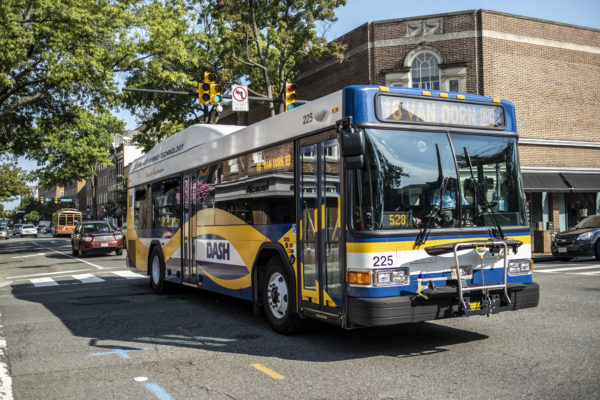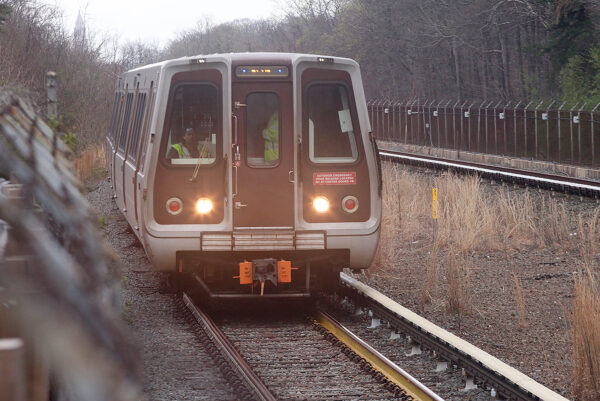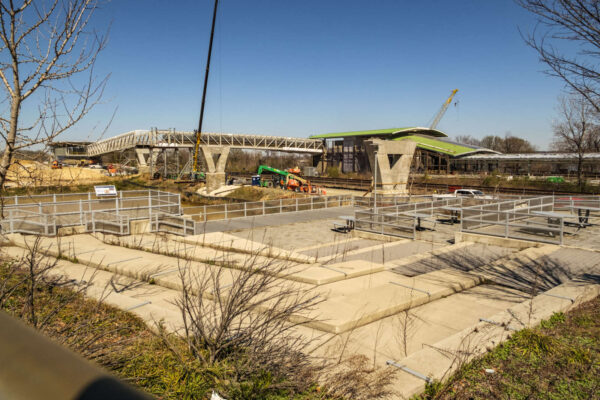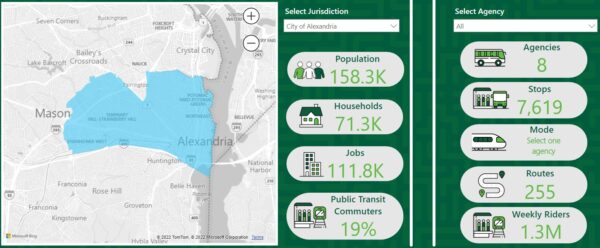
Transportation geeks rejoice, there’s a new and easily accessible dashboard for reviewing Alexandria statistics.
A interactive tool put together by the Northern Virginia Transportation Commission offers a quick snapshot of some transit statistics for Alexandria and its neighbors.
The recently launched NoVa Transit Data Dashboard offers a look at transit information in every Northern Virginia locality, as well as a breakdown of statistics by agencies.
Meet the new NoVaTransit Data Dashboard. Watch the video to see some of the features and check it out here: https://t.co/Mh9c7II74f pic.twitter.com/zPlL4iqaCV
— NVTC (@NoVaTransit) December 15, 2022
The overview for Alexandria notes that around 19% of the city commutes on public transit. The city’s bus service, DASH, has around 81,900 riders weekly along its 12 routes.
A look at ridership over the last five years also shows the slump and recovery that DASH discussed in a recent report.

A map of stops around the city also highlights the new emphasis on high-intensity service around dense corridors — at the cost of service to some of the less dense parts of the city.
The dashboard shows that around 94.7% of the city has access to transit — slightly less than neighboring Arlington’s 95.1% but more than Fairfax County’s 61.3% — with not much variation to that across non-white populations, households below the federal poverty line, or commuters.
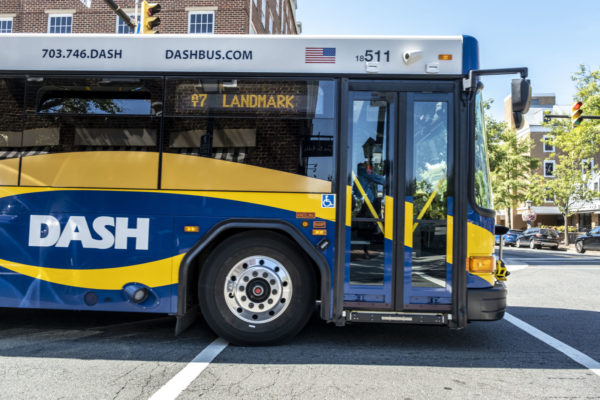
(Updated 10:15 a.m. on 12/14/22) As neighboring D.C. moves forward with a fare-free bus network, Alexandria is looking back at lessons from its own first full year with a fare-free bus network.
Alexandria bus network DASH has released its first annual report on the new initiative that eliminated fares for buses.
The new report looks back at the successes and challenges from that first year — at a time when the budgetary cost means the future of the fare-free program is in question.
The report says the first year of the program has been “tremendously successful by nearly every performance metric” though it also included a look at some challenges from the last year and looming ahead.
According to the report:
- Ridership has doubled from August 2021 to August 2022, with the largest increases occurring during the middays, evenings and weekends — though some of this may be due to the pandemic recovery.
- DASH recorded 380,000 boardings in September 2022, the single-highest month of ridership since 2015. The report said DASH is one of the only agencies in the region that has returned to and surpassed pre-Covid ridership.
- A customer survey said the network redesign and free fares have been two of the largest factors behind ridership growth.
The report also says there’s been an increase in job satisfaction from DASH operators, though negative interactions with passengers have increased. Customer feedback has been positive, the report said, though concerns have been raised about overcrowding — particularly on routes with large numbers of high school students.
The report says lines 31, 35 and 36 all serve a large number of high school students and the buses have seen overcrowding.
“Each of these routes are typically running every 10-15 minutes,” the report said, “however, DASH has mostly addressed these overcrowding hotspots by assigning larger 40-foot and 60-foot buses to the busiest trips and adding several unscheduled trips designed to provide adequate capacity during these periods of heightened ridership demand.”
There have also been challenges in quantifying ridership.
“First, since DASH has not yet finished its project to install automated passenger counters (APC’s) on all DASH buses, ridership data is still being collected manually by operators pressing a button for each passenger boarding,” the report said. “This method is not ideal as it means that bus operators need to count passengers in addition to their regular driving duties, which can be difficult with increased ridership and all-door boarding.”
The report also said ridership data previously collected via SmarTrip cards is no longer available, giving DASH less insight into transfers or rider types.
As the City of Alexandria heads into a tight budget season, one of the most relevant parts of the report could be the financial impacts of the program. The report looks at how much has been lost in fare revenues and where DASH can try to cover some of that loss.
According to the report:
The most significant financial impact from free fares is the loss of passenger revenues, which has traditionally been the single largest revenue source for DASH. In a typical pre-COVID year, DASH would collect approximately $4 million in passenger fares, however, that amount had decreased by more than half during the height of the pandemic. With the rapid return of ridership in FY 2022, DASH estimates that it might have collected an additional $3.5-4.0 million in revenues if the regular $2.00 fare had been collected.
DASH said that lost revenue was offset by a $1.5 million increase in the DASH subsidy from the City of Alexandria and an additional $2.6 million in grant funding from a state program.
The report notes that fare collection is, at the very least, unlikely to resume before FY 2026 — per the stipulations of the state grant.
“If DASH were to resume fare collection prior to FY 2026, the total state grand award ($7.2 million) would need to be returned,” the report said.
In the meantime, the report said DASH is still looking for alternative sources of funding.
“The budgetary impact from the first year of free fares has been largely offset by subsidy increases and state grant funding,” the report said, “while DASH continues to identify additional savings in capital and operating expenses.”
The following press release was just published by the City of Alexandria.
The “DASHing Words in Motion” poetry contest brings recognition to writers, promotes an appreciation of poetry as an art form, and provides inspiration to individuals using the Alexandria Transit Company’s DASH Buses and Trolleys. The contest encourages quality writing by participants 16 years of age or older, who live, work or study in the City of Alexandria. Contest winners will have their poems on exhibit on DASH buses and trolleys throughout the City, as well as displayed on websites, social media platforms, brochures and flyers.
The online submission deadline for the DASHing Words in Motion is Friday, January 27, 2023. To submit poetry click here.
For additional information about the literary program, visit the Office of the Arts website: alexandriava.gov/Arts or email [email protected].
For reasonable disability accommodation, contact [email protected] or 703.746.5565, Virginia Relay 711.
The competition caps off a pretty good year for DASH, though there’s some discussion about whether the fare-free system will be sustainable.
City staff said changes to the DASH bus network over the last year have been a monumental success, but one with a high cost only likely to increase over time.
Over the last two years, Alexandria’s DASH bus system has gone through a series of dramatic changes, from a complete overhaul of the route system to changes to strollers and how the buses are boarded. But at a City Council retreat last week, city staff made it very clear the current balance of costs and revenue spells trouble in the near term.
“On the capital side, with what we have set aside for bus replacement, the cost of maintaining a state of good repair and electrifying [the bus fleet], we’re struggling to find the funds to do all that work,” said Yon Lambert, director of the Department of Transportation and Environmental Services (T&ES).
Lambert said it’s important to keep that swelling cost in mind as the city heads into budget season this spring.
“On the DASH side, we’re doing some fantastic things in transit, but the challenge for us is that operating what I would consider a best-in-class transit system is challenging and expensive,” Lambert said. “Operating costs are expensive and we need to make sure we head into this with eyes wide open.”
Lambert said that, at the current rate, in just a few years the DASH subsidy will increase from the current $23.6 million to $45 million annually.
City Council member John Chapman said the discussion raised red flags about the bus system’s future and broached the question of whether or not fare-free will remain a permanent state for the bus system.
“To me: saying transit investments need to be placed on a sustainable path and not presenting what that pathway is is a big red flag to me,” Chapman said. “To say ‘hey, we don’t have this money and we don’t think it’s going to happen,’ so how do we look at cutting back or finding other opportunities to put us on a sustainable path?”
Chapman said those discussions about putting DASH onto a more sustainable path are going to have to happen sooner rather than later.
“I want to be helpful, but I want to hear solutions for right now rather than further in the future because we are going to have budgetary decisions to make in the spring,” Chapman said. “If we’re going to do fare-free: how do we make that sustainable or is that a program we do for a few years and then find a way to not do that?”
Staff said DASH was collecting around $4 million in fares before the fare-free program was put into effect — not an insignificant amount, but still not enough to accommodate for the DASH expenditures.
“When we get to budget season, I want to have those hard conversations instead of saying ‘we’re going to have a 14% increase on transit [costs]’ and then keep moving,” Chapman said. “We need to be able to go back to taxpaying residents and businesses and say ‘we understand this is going to affect your standard of living coming out of a pandemic and into a possible recession, and we are still doing the best with our funding that we can.'”
Lambert said figures from DASH and Metro recovery showed buses recovered ridership more quickly from the pandemic than Metro did, saying the numbers emphasized that buses are the real “people movers” in Alexandria and did much of the heavy lifting for public transit during the pandemic.
Mayor Justin Wilson said there may be room to expand DASH operations while still making more efficient use of city funding by folding some aspects of the city school bus network into DASH. Wilson said the city could reach a place where DASH buses replace middle and high school bus services for Alexandria City Public Schools (ACPS).
“This is an opportunity,” Wilson said. “Anything we can do to use capacity we’ve already invested in more efficiently is a good thing. The opportunity for partnership with ACPS is one of those opportunities, particularly at the middle school and high school levels.”
Wilson said the future of public transportation could involve replacing school buses for high school and middle school students with DASH bus lines.
“I want to be explicit: it’s not just ‘hey we can supplement what they’re doing,’ it’s potentially figuring out a way we get rid of ACPS transportation for middle and high and come up with a scenario where DASH route network can do that,” Wilson said.
DASH’s financial forecast is one part of a looming challenge for the city — a swelling budget faced with stagnating growth in a potential “pasta bowl recession.” According to Arthur Wicks, budget manager of the Capital Improvement Program:
We’ve embarked on a very ambitious capital program over the last couple of years… the big takeaway is: the expense of having a CIP the size we have is going to exceed what revenue growth can absorb. Our capital programs have become larger and more complex than what we can execute. We’ve come to you during the last few years of retreats and said a big CIP expense increase is coming and we find ways to shave it down and make it bearable. We’ve kind of used up our bag of tricks on that.
With Labor Day coming up on Monday, a couple of the leading unions and labor organizing groups in Alexandria say they’ve seen substantial gains but there’s still work to be done.
Collective bargaining for public safety agencies was one of the leading issues early in late 2021 and early 2022. Labor activists were also critical of the city’s involvement in financing the development of the Hotel Heron in Old Town, saying the city should leverage its position to ensure better wages and treatment of employees.
In recent years, Alexandria labor activists have also worked with human rights advocates in protests against evictions and poor living conditions.
NoVa Labor
The Northern Virginia Labor Federation (NoVA Labor) is an umbrella organization that encompasses unions in all segments of the economy. Virginia Diamond, President of the NoVA Labor, said the organization includes 55 different labor organizations and 70,000 members across the state.
Diamond said union organizing is on the rise as Virginia’s workforce grapples with the economic impact of the pandemic.
“This year NoVA Labor has seen a great upsurge in union organizing,” Diamond said. “This is a result of the impact of the pandemic on workers, as well as a generational revolt against an economy that offers young workers little hope for the future.”
Alexandria in particular has been at the forefront of union organizing in Virginia, Diamond said.
“Alexandria is a progressive community that values equity and economic justice, so there is widespread support for unions,” Diamond said. “When the General Assembly adopted a statute enabling localities to allow public employees to engage in collective bargaining, Alexandria was the first locality in Virginia to adopt such an ordinance.”
Diamond said one of the major labor concerns is wage theft and exploitation in the construction industry.
“Soon the City will address this problem by adopting a prevailing wage and using community benefit agreements, also known as project labor agreements,” Diamond said.
Beyond combatting wage theft, Diamond said one of the critical pieces of labor reform is offering low-income communities in Alexandria better access to higher-paying trades and careers.
“Building trades unions are reaching out to low-income communities in Alexandria to offer free paid apprenticeships leading to middle-class careers in the skilled trades,” Diamond said. “The Alexandria Democrats Labor Caucus, headed by Russ Davis and Sean Casey, bring together union members and friends of labor to publicize and educate the community on issues affecting workers.”
Diamond said a driving force behind union organizing is the dire levels of income inequality.
“Income inequality is at a level of the Gilded Age, and unionization in the private economy is at only 6%, down from 34% four decades ago,” Diamond said. “Income inequality is a grave concern to Alexandrians, and the most important vehicle for addressing this inequality is unionization. Just as factory workers in the 1930’s and ’40’s organized and built the middle class, workers in the service economy are now organizing to rebuild the middle class.”
Diamond said she’s encouraged by union victories at companies like Starbucks, Amazon, Apple, Chipotle, REI and Trader Joe’s:
The popularity of unions is now at 71%, higher than any time since the 1960’s. The resurgent labor movement is just getting started. Hopefully over the next year we will see the first union hotel, the first union Starbucks, and the first union health care facilities in Alexandria. With the support of the Alexandria community and city leaders, workers will achieve the dignity, respect and living standards that they deserve. Good jobs are union jobs, and good union jobs will enable workers to afford to continue to live in this community.
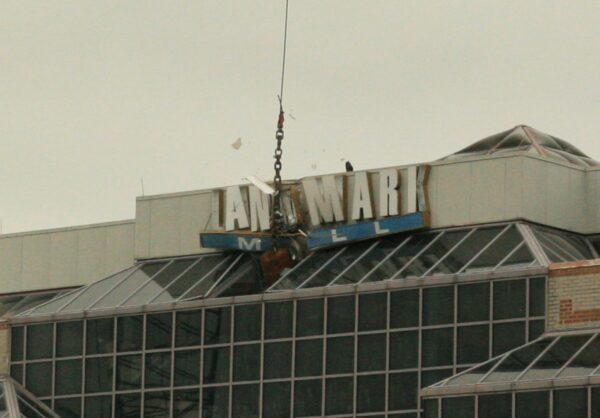
In addition to being a mall and Wonder Woman battleground, Landmark has also served as a major transfer junction for Alexandria bus riders: but that changes this week as the mall’s redevelopment has forced DASH to relocate.
According to the DASH website, the transit center’s closure is necessary as mall demolition removes a ramp connecting Duke Street to the junction.
“Beginning Monday, August 1, the Landmark Mall Transit Center will be closed to all bus traffic for several weeks for construction,” the bus service said on the site. “This closure is necessary to remove the flyover ramp connecting eastbound Duke Street to the mall. The closure is part of the ongoing redevelopment of Landmark Mall.”
The demolition is part of a redevelopment plan that aims to turn the site into a new hospital and mixed-use development. The project is currently slated for completion in 2026.
A chart on the DASH site outlines what transfers bus riders on lines 30, 32 and 35 should make.
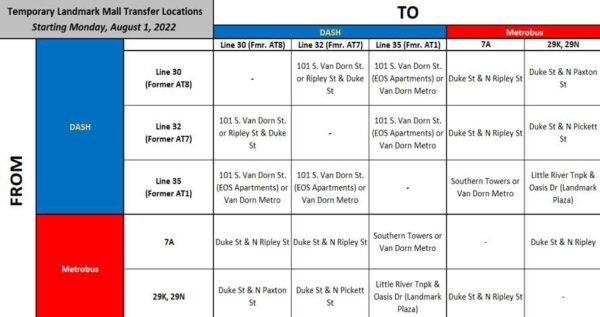
While DASH won’t be able to cover the service gap from the upcoming Metro closures, WMATA announced some new measures yesterday that will attempt to replace Alexandria’s upcoming loss of Metro service.
There are two Metro shutdowns coming to Alexandria that will, together, eliminate or reduce Metro service in Alexandria from September to next May. The first is a shutdown of all stations south of the new Potomac Yard Metro station. The Potomac Yard closure is expected to last from Sept. 10 to Oct. 22. The Potomac Yard closure overlaps with the start of work on the Yellow Line Bridge from Sept. 10 to May. During the much longer Yellow Line Bridge closure, riders will have to take the Blue Line to Rosslyn to cross over into D.C.
During the Potomac Yard shutdown, Metro said in a release that it will be operating additional Blue Line trains, running every seven to nine minutes, from National Airport to New Carrollton stations. At the same time, Metro said customers traveling between Pentagon and L’Enfant Plaza stations should plan for approximately 15 minutes of extra travel time.
Metro also notes that if the 7000-series trains remain out of service the trains will operate less frequently.
During this first phase, WMATA said that free shuttle service will be offered in Virginia with three shuttles crossing the Potomac.
Local shuttles will be available during all Metrorail operating hours.
- Blue Line Local: Local service between Franconia-Springfield, Van Dorn St, King St-Old Town, Braddock Rd, and Ronald Reagan Washington National Airport stations every 10-20 minutes
- Yellow Line Local: Local service between Huntington, Eisenhower Ave, King St-Old Town, Braddock Rd, and Crystal City stations every 10-15 minutes. Yellow Line shuttles do not stop at Ronald Reagan Washington National Airport Station
Express shuttles will be available most of the day (from 4:30 a.m. to 9:00 p.m., 6:30 am to 9:00 p.m weekends).
- Blue Line Express: Franconia-Pentagon Express service between Franconia-Springfield and Pentagon stations every 6 minutes
- Yellow Line Express: Huntington-Pentagon Express service between Huntington and Pentagon stations every 6 minutes
Limited shuttles will be available during weekday rush hours only.
- VA-DC Shuttle 1: Crystal City-L’Enfant Service between Crystal City, Pentagon City, Smithsonian, and L’Enfant Plaza stations every 12 minutes. Shuttle does not stop at Pentagon Station
- VA-DC Shuttle 2: Pentagon-Archives Service between Pentagon, Smithsonian, and Archives stations every 12 minutes
- VA-DC Shuttle 3: Mt. Vernon-Potomac Park (11Y Route) Service between Mt. Vernon, Alexandria, and Potomac Park every 20 minutes. Peak direction service only
Meanwhile, during Phase 2, the Potomac Yard Metro station will be reopened but the bridge will remain closed. All Yellow Line stations will be served by the Blue or Green Lines. Blue Line trains will run every 12 minutes between Largo Town Center and Franconia-Springfield stations and every 12 minutes between Huntington and New Carrollton stations. The Green Line trains will operate every eight minutes.
Metro said there will continue to be a limited rush hour shuttle service during this time.
- VA-DC Shuttle 1: Crystal City-L’Enfant: Service between Crystal City, Pentagon City, Smithsonian, and L’Enfant Plaza stations every 12 minutes. Shuttle does not stop at Pentagon Station
- VA-DC Shuttle 2: Pentagon-Archives: Service between Pentagon, Smithsonian, and Archives stations every 12 minutes
- VA-DC Shuttle 3: Mt. Vernon-Potomac Park (11Y Route): Service between Mt. Vernon, Alexandria, and Potomac Park every 20 minutes. Peak direction service only
Additionally, Metro said riders could opt to take the 16Y Columbia Pike-Farragut Square Line, Metroway, or ride the Virginia Railway Express.
Today @wmata has released their initial package of travel alternatives for the system work impacting Alexandria beginning this fall.
These alternatives reiterate the need to restore 7000-series cars prior to proceeding with these important projects:https://t.co/SiCEU1bE0h
— Justin Wilson (@justindotnet) June 15, 2022
The City of Alexandria could be turning to state funding to try to mitigate the impacts of a pair of upcoming Metro closures.
At the same time, city staff wrote in a memo that it’s increasingly apparent the city’s DASH bus network doesn’t have the manpower to support additional bus routes making up for the loss of Metro service.
The impacts are from two Metro projects coming up: a shutdown of all stations south of the new Potomac Yard Metro station and the closure of the Yellow Line Bridge across the Potomac. The Potomac Yard closure is only expected to last from Sept. 10 to Oct. 22, but the Yellow Line Bridge closure is expected to run from Oct. 23 to next May. During the much longer Yellow Line Bridge closure, riders will have to take the Blue Line to Rosslyn to cross over into D.C.
During previous shutdowns, the city’s DASH bus network helped to fill the gap left by Metro. But Hillary Orr, deputy director of Transportation and Environmental Services, wrote in a memo that DASH doesn’t have the bus drivers to pick up that slack this time around.
“DASH buses are not anticipated to play the same role they did during the 2019 Platform Improvement Project due to a lack of operators to take on additional routes,” Orr wrote.
There are still likely to be more buses to try to cover that gap, but they’ll be WMATA buses. Orr said that city staff hoping to ask the state for $1 million for support.
The grant application is scheduled to be reviewed at a Transportation Commission meeting on Wednesday, June 15.
“WMATA has prepared a mitigation plan that includes shuttle bus bridges and a commitment to increased frequency on the Blue line rail service,” Orr wrote. “The City has also prepared a mitigation plan to support travel options for residents and workers in Alexandria. [Department of Rail & Public Transportation] has announced that $2 million is available to support jurisdictions with these mitigation plans.”
Orr said the City of Alexandria has also been putting together a mitigation plan, which includes:
- Robust communication, marketing and employer outreach, in partnership with WMATA
- Access to transportation options such as the water taxi, discounted Capital Bikeshare memberships, HOV lane changes, enhanced way-finding, and discounted or free travel on Virginia Railway Express (VRE)
- Enhanced support for data monitoring such as bike trail counters, StreetLight data
DASH is making some changes to the bus network in Old Town, including one change that has residents concerned.
At a meeting of the Transportation Commission yesterday, DASH Director of Planning & Marketing Martin Barna outlined plans to adjust DASH service in coordination with the opening of the Potomac Yard Metro station. Among those changes is one Barna said has proven contentious to residents along the affected route.
Route 34, which currently runs from the Lee Center to Braddock Road Metro station, will be changed to connect up to the Potomac Yard Metro station instead. As part of that change, DASH is planning to realign the route from N. Fairfax Street to N. Pitt Street.
“This is far and away the most contentious part of our proposal,” said Barna. “We’ve received 30-35 comments from residents along Pitt Street who don’t want to see DASH service along that street for parking and noise concerns.”
Barna said residents along the street have expressed concerns at more congestion caused by the new bus route, while DASH is hoping the shift will provide a more useful route through Old Town North.
“N. Fairfax street is well served by the 30 and 31, which are more frequent,” Barna said. “Nearly all ridership along that stretch are those [lines].”
Without this change, Barna said there will continue to be a four-block gap in DASH coverage between Washington Street and Fairfax Street. With new apartment complexes and grocery stores coming to that area, Barna said DASH saw the change as a good opportunity to potentially provide more service.
One of the other changes for Potomac Yard DASH routes is that the 33 and the 36, which currently go to Potomac Yard, will continue serving the shopping center but will go to the Metro station first.
“We’re trying to make sure the people trying to catch trains can go directly there,” Barna said.
Barna also provided the Transportation Commission with an update on the fare-free and electric bus programs. With DASH ridership going up, Commissioners asked Barna how much money was being taken off the table by the fare-free program.
“Last year council increased budget by $1.5 million to offset lost revenues,” Barna said. “Before the pandemic we were making $3.5-4 million in revenue but we’re not back to that point. It’s hard to say whether riding because fares are free or because they’d normally be riding.”
Barna said that $3.5 million could pay for around three electric buses, which are more expensive than diesel ones, but that DASH doesn’t currently have the infrastructure to support the additional buses anyway. DASH is currently “aggressively pursing grants” to boost the bus system’s electric infrastructure, Barna said, as well as working through the development process for a facilities expansion.
Starting today (Monday), Alexandria’s DASH bus network is going through some changes to how riders board buses and how strollers can be used.
While passengers before could only enter buses through the front doors, DASH is changing its policy for riders to be able to use either door.
“When it is safe to do so, riders may board using the front or rear doors,” the bus service said in a release. “Passengers with limited mobility are encouraged to continue using the front of the bus which can be lowered for easier boarding.”
Riders had earlier been encouraged to board using either door as a Covid precaution during the first year of the pandemic, though it changed back to front-boarding last year. Now, with bus fares eliminated, DASH said it’s returning to all-door boarding on all buses.
“The benefits of all-door boarding include easier passenger boarding and reduced dwell time at bus stops, which provides faster, more reliable service,” the release said. “As with the front door, passengers boarding at the rear door are encouraged to allow others to step off the bus before attempting to board. Passengers with mobility devices, or who have difficulty boarding the bus are encouraged to continue using the front of the bus, which has a ramp and can be lowered.”
Another change is allowing strollers to be used on the bus if the ADA-accessible space is not in use. Previously, all strollers had to be folded and stowed upon boarding. Under the new guidelines:
If ADA accessible seating is not in use, strollers are permitted in this space without being folded or stowed as long as the wheels are locked, the child is properly secured in the stroller seat, the parent or guardian maintains control of the stroller, and the aisle is not blocked.
The release said the change was guided by input from riders.
“It’s important that DASH service continues evolving to meet the needs of our community,” DASH Planning and Marketing Director Martin Barna said in the release. “Allowing strollers to be used during trips and opening all doors for boarding will improve our riders’ overall experience and encourage more people to consider using DASH.”
The changes come as DASH is starting to see ridership rebound from low figures during Covid and an omicron-related slump in January.



